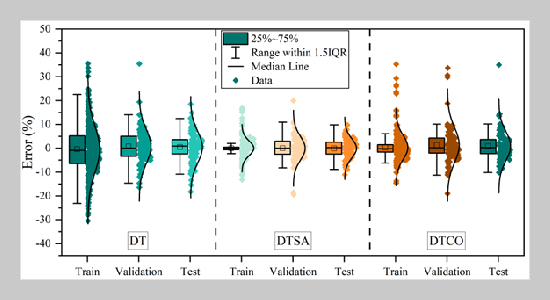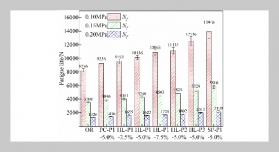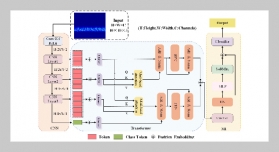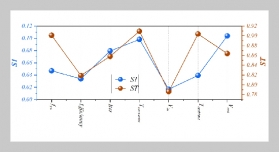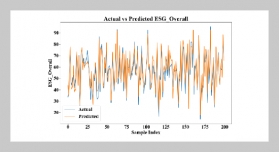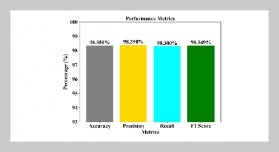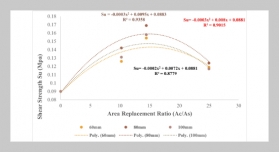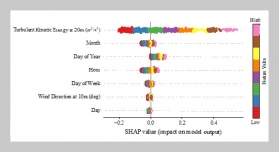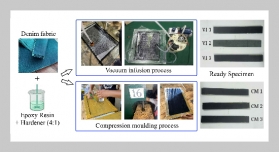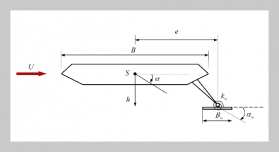- [1] A. Salawudeen, M. Mu’azu, Y. Sha’aban, and E. Ade�dokun. “On the development of a novel smell agent optimization (SAO) for optimization problems”. In: 2nd International Conference on Information and Com�munication Technology and its Applications (ICTA 2018), Minna. 2018. DOI: 10.26634/jpr.5.4.15677.
- [2] A. T. Salawudeen, M. B. Mu’azu, A. Yusuf, and A. E. Adedokun, (2021) “A Novel Smell Agent Optimization (SAO): An extensive CEC study and engineering appli�cation" Knowledge-Based Systems 232: 107486. DOI: https://doi.org/10.1016/j.knosys.2021.107486.
- [3] G. Ke, Q. Meng, T. Finley, T. Wang, W. Chen, W. Ma, Q. Ye, and T.-Y. Liu, (2017) “Lightgbm: A highly efficient gradient boosting decision tree" Advances in neural information processing systems 30:
- [4] A. Karbassi, B. Mohebi, S. Rezaee, and P. Lestuzzi, (2014) “Damage prediction for regular reinforced concrete buildings using the decision tree algorithm" Computers & Structures 130: 46–56. DOI: https://doi.org/10.1016/j.compstruc.2013.10.006.
- [5] N. Patel and S. Upadhyay, (2012) “Study of various decision tree pruning methods with their empirical com�parison in WEKA" International journal of computer applications 60: DOI: 10.5120/9744-4304.
- [6] H. I. Erdal, (2013) “Two-level and hybrid ensembles of decision trees for high performance concrete compressive strength prediction" Engineering Applications of Ar�tificial Intelligence 26: 1689–1697. DOI: https://doi.org/10.1016/j.engappai.2013.03.014.
- [7] W. Pessenlehner and A. Mahdavi. Building morphol�ogy, transparence, and energy performance. Citeseer, 2003.
- [8] H. Liu, J. Liang, Y. Liu, and H. Wu, (2023) “A re�view of data-driven building energy prediction" Build�ings 13: 532. DOI: https://doi.org/10.3390/buildings13020532.
- [9] K. P. Wai, M. Y. Chia, C. H. Koo, Y. F. Huang, and W. C. Chong, (2022) “Applications of deep learning in water quality management: A state-of-the-art review" Journal of Hydrology 613: 128332. DOI: https://doi.org/10.1016/j.jhydrol.2022.128332.
- [10] S. S. Roy, P. Samui, I. Nagtode, H. Jain, V. Shiv�aramakrishnan, and B. Mohammadi-Ivatloo, (2020) “Forecasting heating and cooling loads of buildings: A comparative performance analysis" Journal of Ambient Intelligence and Humanized Computing 11: 1253– 1264. DOI: https://doi.org/10.1007/s12652-019-01317-y.
- [11] A. Moradzadeh, A. Mansour-Saatloo, B. Mohammadi-Ivatloo, and A. Anvari-Moghaddam, (2020) “Performance evaluation of two machine learning techniques in heating and cooling loads forecasting of residential buildings" Applied Sciences 10: 3829. DOI: https://doi.org/10.3390/app10113829.
- [12] S. Afzal, B. M. Ziapour, A. Shokri, H. Shakibi, and B. Sobhani, (2023) “Building energy consumption predic�tion using multilayer perceptron neural network-assisted models; comparison of different optimization algorithms" Energy 282: 128446. DOI: https://doi.org/10.1016/j.energy.2023.128446.
- [13] B. Sadaghat, S. Afzal, and A. J. Khiavi, (2024) “Resi�dential building energy consumption estimation: a novel ensemble and hybrid machine learning approach" Expert Systems with Applications 251: 123934. DOI: https://doi.org/10.1016/j.eswa.2024.123934.
- [14] M. Sajjad, S. U. Khan, N. Khan, I. U. Haq, A. Ullah, M. Y. Lee, and S. W. Baik, (2020) “Towards efficient building designing: Heating and cooling load prediction via multi-output model" Sensors 20: 6419. DOI: https://doi.org/10.3390/s20226419.
- [15] C. Wang, J. Yuan, K. Huang, J. Zhang, L. Zheng, Z. Zhou, and Y. Zhang, (2022) “Research on thermal load prediction of district heating station based on transfer learning" Energy 239: 122309. DOI: https://doi.org/10.1016/j.energy.2021.122309.
- [16] Y. Lu, Z. Tian, Q. Zhang, R. Zhou, and C. Chu, (2021) “Data augmentation strategy for short-term heating load prediction model of residential building" Energy 235: 121328. DOI: https://doi.org/10.1016/j.energy.2021.121328.
- [17] R. Chaganti, F. Rustam, T. Daghriri, I. de la Torre Díez, J. L. V. Mazón, C. L. Rodríguez, and I. Ashraf, (2022) “Building heating and cooling load prediction us�ing ensemble machine learning model" Sensors 22: 7692. DOI: https://doi.org/10.3390/s22197692.
- [18] R. Chaganti, F. Rustam, T. Daghriri, I. de la Torre Díez, J. L. V. Mazón, C. L. Rodríguez, and I. Ashraf, (2022) “Building heating and cooling load prediction us�ing ensemble machine learning model" Sensors 22: 7692. DOI: https://doi.org/10.3390/s22197692.
- [19] J. Ling, N. Dai, J. Xing, and H. Tong, (2021) “An im�proved input variable selection method of the data-driven model for building heating load prediction" Journal of Building Engineering 44: 103255. DOI: https://doi.org/10.1016/j.jobe.2021.103255.
- [20] Q. Zhang, Z. Tian, Z. Ma, G. Li, Y. Lu, and J. Niu, (2020) “Development of the heating load prediction model for the residential building of district heating based on model calibration" Energy 205: 117949. DOI: https://doi.org/10.1016/j.energy.2020.117949.
- [21] G. Xue, Y. Pan, T. Lin, J. Song, C. Qi, and Z. Wang, (2019) “District heating load prediction algorithm based on feature fusion LSTM model" Energies 12: 2122. DOI: https://doi.org/10.3390/en12112122.
- [22] J. Song, L. Zhang, G. Xue, Y. Ma, S. Gao, and Q. Jiang, (2021) “Predicting hourly heating load in a district heat�ing system based on a hybrid CNN-LSTM model" Energy and Buildings 243: 110998. DOI: https://doi.org/10.1016/j.enbuild.2021.110998.
- [23] J. Yuan, Z. Zhou, H. Tang, C. Wang, S. Lu, Z. Han, J. Zhang, and Y. Sheng, (2020) “Identification heat user behavior for improving the accuracy of heating load pre�diction model based on wireless on-off control system" Energy 199: 117454. DOI: https://doi.org/10.1016/j.energy.2020.117454.
- [24] Y. Zhang, Z. Zhou, J. Liu, and J. Yuan, (2022) “Data augmentation for improving heating load prediction of heating substation based on TimeGAN" Energy 260: 124919. DOI: https://doi.org/10.1016/j.energy.2022.124919.
- [25] G. Xue, C. Qi, H. Li, X. Kong, and J. Song, (2020) “Heating load prediction based on attention long short term memory: A case study of Xingtai" Energy 203: 117846. DOI: https://doi.org/10.1016/j.energy.2020.117846.
- [26] Q. Zhang, Z. Tian, Z. Ma, G. Li, Y. Lu, and J. Niu, (2020) “Development of the heating load prediction model for the residential building of district heating based on model calibration" Energy 205: 117949. DOI: https://doi.org/10.1016/j.energy.2020.117949.
- [27] E. Guelpa, L. Marincioni, M. Capone, S. Deputato, and V. Verda, (2019) “Thermal load prediction in district heating systems" Energy 176: 693–703. DOI: https://doi.org/10.1016/j.energy.2019.04.021.
- [28] Y. Zhang, Z. Zhou, J. Liu, and J. Yuan, (2022) “Data augmentation for improving heating load prediction of heating substation based on TimeGAN" Energy 260: 124919. DOI: https://doi.org/10.1016/j.energy.2022.124919.
- [29] B. Sadaghat, A. J. Khiavi, B. Naeim, E. Khajavi, H. Sadaghat, and A. R. T. Khanghah, (2023) “The uti�lization of a naïve bayes model for predicting the energy consumption of buildings" Journal of Artificial Intel�ligence and System Modelling 1: 73–91. DOI: 10.22034/jaism.2023.422292.1003.
- [30] A. Botchkarev, (2018) “Performance metrics (error mea�sures) in machine learning regression, forecasting and prognostics: Properties and typology" arXiv preprint arXiv:1809.03006: DOI: https://doi.org/10.48550/arXiv.1809.03006.
- [31] O. A. Meadows, M. B. Mu’Azu, and A. T. Salawudeen. “A smell agent optimization approach to capacitated vehicle routing problem for solid waste collection”. In: 2022 IEEE Nigeria 4th Interna�tional Conference on Disruptive Technologies for Sustain�able Development (NIGERCON). IEEE. 2022, 1–5. DOI: 10.1109/NIGERCON54645.2022.9803009.
- [32] A. T. Bankole, S. O. Moses, and T. Y. Ibitoye. “Smell Agent Optimization Based Supervisory Model Pre�dictive Control for Energy Efficiency Improvement of a Cold Storage System”. In: 2022 IEEE Nigeria 4th International Conference on Disruptive Technologies for Sustainable Development (NIGERCON). IEEE. 2022, 1– 5. DOI: 10.1109/NIGERCON54645.2022.9803096.


